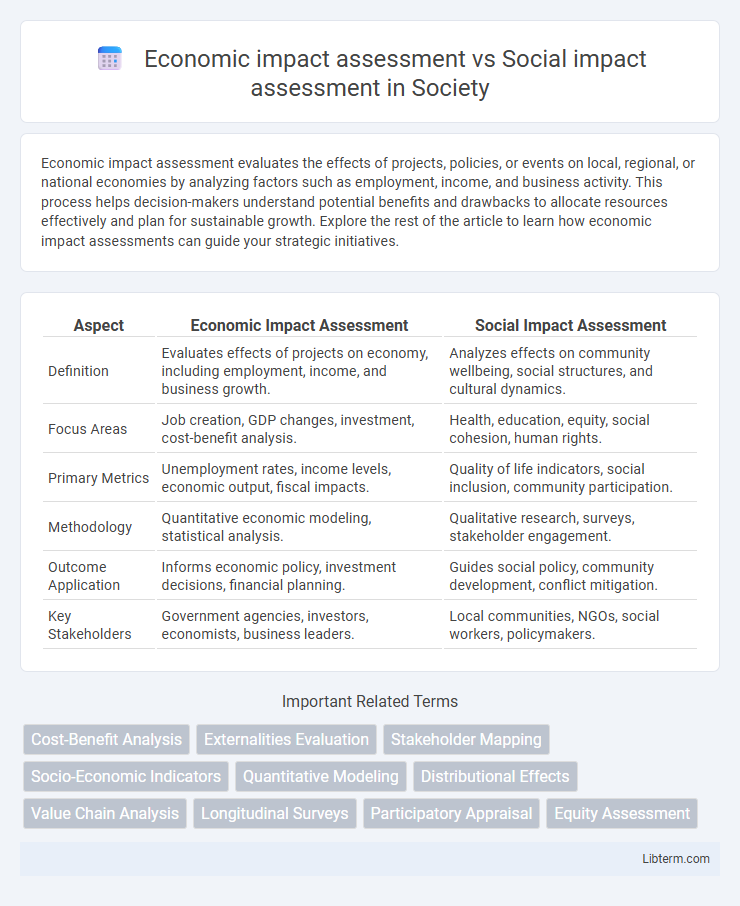Economic impact assessment evaluates the effects of projects, policies, or events on local, regional, or national economies by analyzing factors such as employment, income, and business activity. This process helps decision-makers understand potential benefits and drawbacks to allocate resources effectively and plan for sustainable growth. Explore the rest of the article to learn how economic impact assessments can guide your strategic initiatives.
Table of Comparison
| Aspect | Economic Impact Assessment | Social Impact Assessment |
|---|---|---|
| Definition | Evaluates effects of projects on economy, including employment, income, and business growth. | Analyzes effects on community wellbeing, social structures, and cultural dynamics. |
| Focus Areas | Job creation, GDP changes, investment, cost-benefit analysis. | Health, education, equity, social cohesion, human rights. |
| Primary Metrics | Unemployment rates, income levels, economic output, fiscal impacts. | Quality of life indicators, social inclusion, community participation. |
| Methodology | Quantitative economic modeling, statistical analysis. | Qualitative research, surveys, stakeholder engagement. |
| Outcome Application | Informs economic policy, investment decisions, financial planning. | Guides social policy, community development, conflict mitigation. |
| Key Stakeholders | Government agencies, investors, economists, business leaders. | Local communities, NGOs, social workers, policymakers. |
Introduction to Impact Assessments
Economic impact assessment evaluates the monetary consequences of projects, policies, or events on local, regional, or national economies by analyzing factors such as employment, income, and productivity changes. Social impact assessment examines the effects on community well-being, social cohesion, and quality of life, including changes in health, education, and cultural dynamics. Both assessments provide essential frameworks to inform decision-making by predicting positive and negative outcomes and guiding sustainable development strategies.
Defining Economic Impact Assessment
Economic Impact Assessment evaluates the financial effects of a project or policy by analyzing changes in employment, income, business revenue, and tax revenues within a specific region. It quantifies direct, indirect, and induced economic activities to determine overall economic growth or decline. This assessment provides critical data to guide investment decisions, policy formulation, and resource allocation for sustainable economic development.
Understanding Social Impact Assessment
Social impact assessment (SIA) evaluates the consequences of projects or policies on community well-being, social structures, and quality of life, emphasizing human and cultural factors often missed by economic impact assessments (EIA). Unlike EIA, which quantifies changes in employment, income, and economic activity, SIA analyzes social cohesion, health, equity, and public perception to inform sustainable decision-making. Understanding SIA involves identifying vulnerable groups, assessing potential disruptions, and proposing mitigation measures to enhance social outcomes.
Key Objectives: Economic vs Social Assessments
Economic impact assessment focuses on measuring the effects of a project or policy on economic indicators such as employment, income, and gross domestic product (GDP). Social impact assessment evaluates how these initiatives influence community well-being, social cohesion, and quality of life. Both assessments aim to provide decision-makers with comprehensive insights, with economic assessments prioritizing financial outcomes and social assessments emphasizing human and societal factors.
Methodologies Used in Economic and Social Assessments
Economic impact assessment methodologies primarily employ quantitative techniques such as input-output analysis, cost-benefit analysis, and econometric modeling to evaluate financial outcomes and economic changes within a region or sector. Social impact assessment methodologies focus on qualitative and mixed-method approaches, including stakeholder interviews, focus groups, and surveys, to understand the effects on community well-being, social cohesion, and cultural dynamics. Both assessments integrate data collection and analysis but prioritize different indicators to measure either economic performance or social consequences.
Data Sources for Economic and Social Impact Analysis
Economic impact assessment primarily relies on quantitative data sources such as government economic reports, census data, business financial records, and employment statistics to analyze changes in income, output, and employment levels. Social impact assessment utilizes both quantitative and qualitative data from surveys, interviews, public health records, education statistics, and community feedback to evaluate changes in social well-being, quality of life, and community cohesion. Combining these diverse datasets enhances the accuracy and comprehensiveness of impact analysis, enabling more informed policy and project decisions.
Stakeholder Involvement in Each Assessment
Economic impact assessments prioritize engagement with investors, business owners, and financial institutions to evaluate fiscal benefits and market effects, ensuring data aligns with economic growth and profitability metrics. Social impact assessments emphasize collaboration with community members, local organizations, and vulnerable groups to capture qualitative insights on societal well-being, equity, and cultural implications. Both assessments require tailored stakeholder involvement strategies to accurately reflect the diverse impacts on economic structures and social dynamics.
Comparative Benefits and Limitations
Economic impact assessment quantifies changes in economic indicators such as employment, income, and gross domestic product, providing clear metrics for policy and business decisions, while social impact assessment evaluates effects on community well-being, social cohesion, and cultural dynamics, capturing qualitative aspects less tangible in economic terms. Economic assessments excel in providing measurable, quantifiable data to forecast financial benefits or losses, but they may overlook social equity and long-term societal repercussions. Social impact assessments offer comprehensive insights into social justice, health, and quality of life implications, yet they often face challenges in measurement standardization and may lack immediate economic justification.
Real-World Examples: Economic vs Social Outcomes
Economic impact assessment quantifies financial effects such as job creation, revenue growth, and GDP contributions exemplified by infrastructure projects like airports boosting regional economies. Social impact assessment evaluates changes in community well-being, health, education, and cultural dynamics, as seen in urban redevelopment initiatives improving neighborhood cohesion and access to services. Comparing economic outcomes like increased employment rates with social outcomes such as enhanced quality of life reveals a holistic perspective essential for sustainable development planning.
Integrating Economic and Social Impact Assessments
Integrating Economic and Social Impact Assessments (ESIAs) enhances comprehensive project evaluation by combining financial analysis with community well-being metrics, facilitating balanced decision-making. This integrated approach leverages quantitative economic data, such as cost-benefit analysis, alongside qualitative social indicators like cultural impact and social equity, improving risk identification and stakeholder engagement. Effective integration supports sustainable development by addressing interlinked economic growth and social progress objectives within project planning and policy formulation.
Economic impact assessment Infographic

 libterm.com
libterm.com